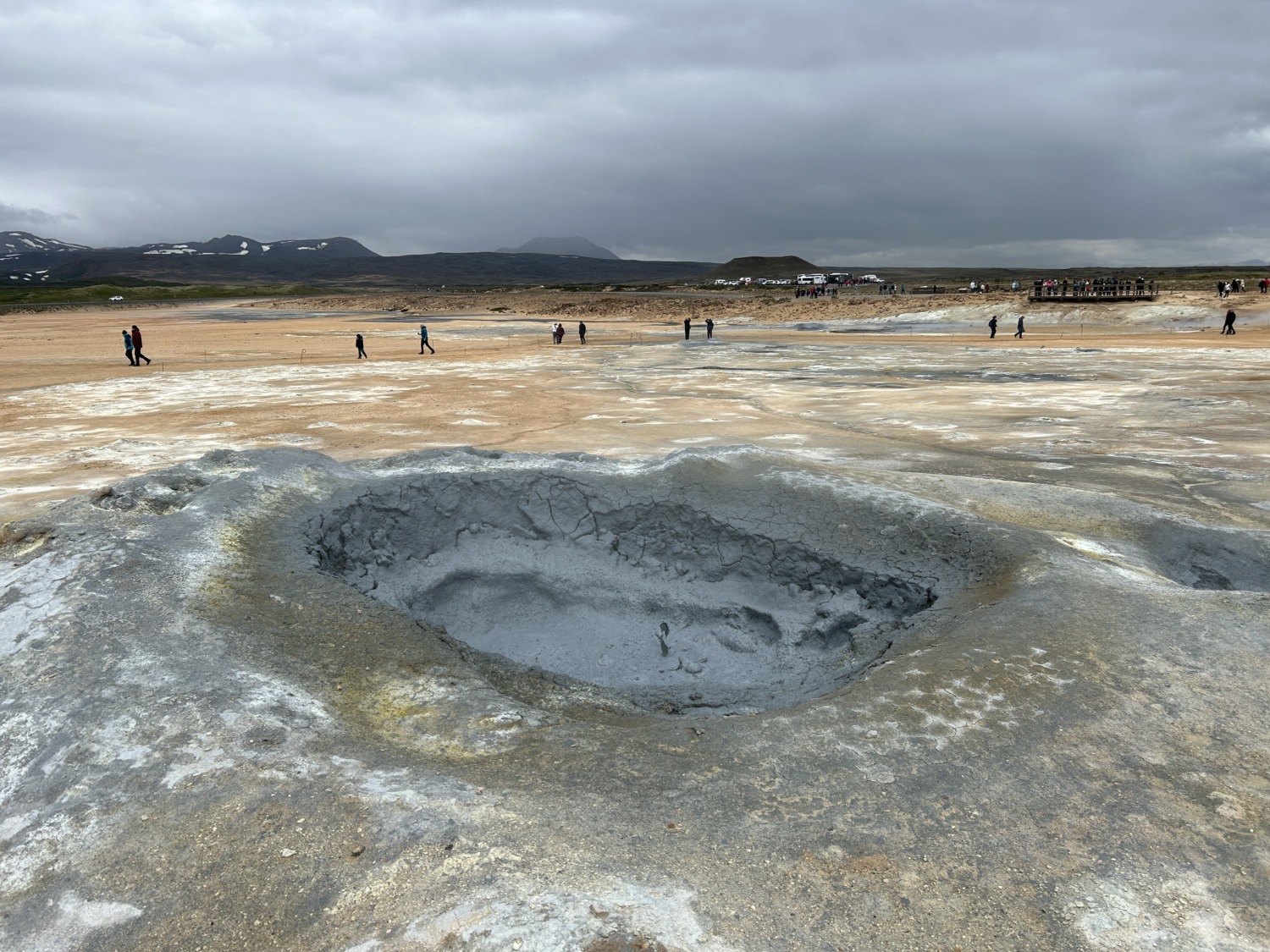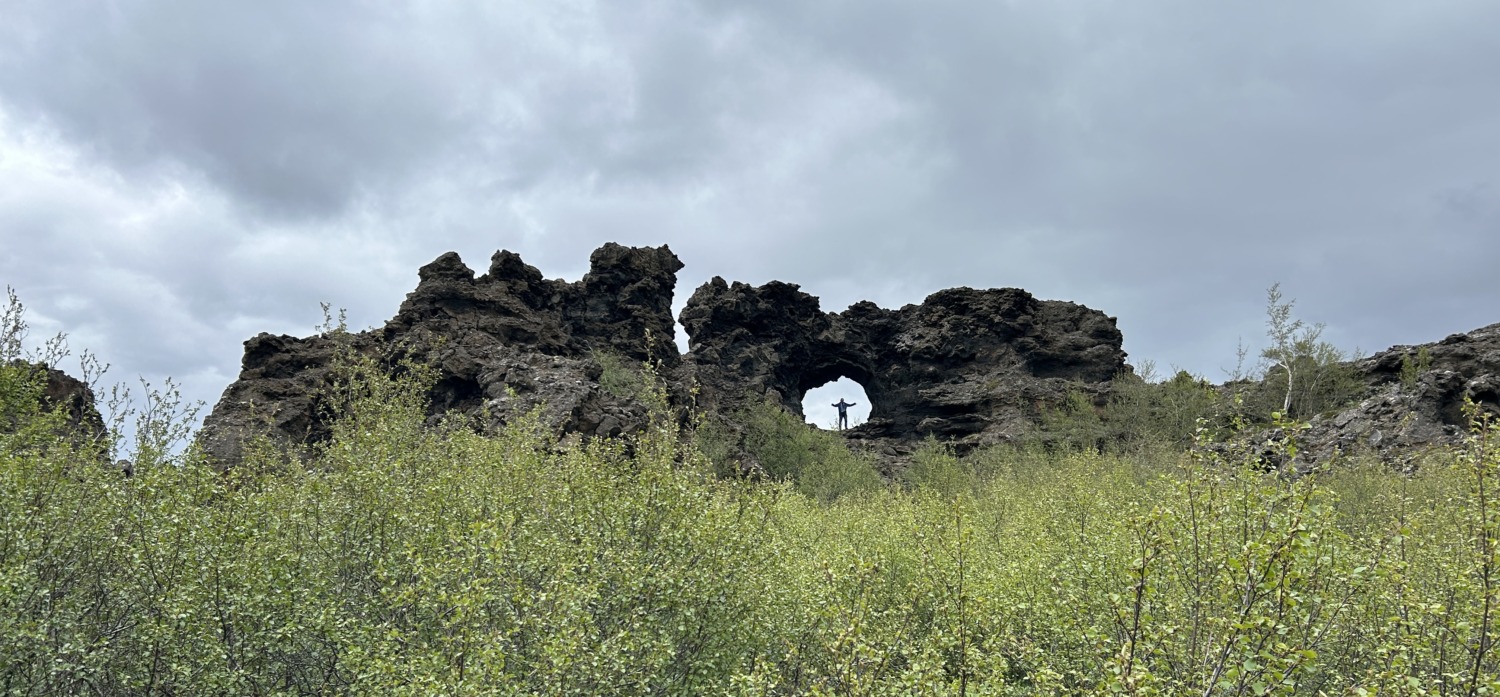Our first day in Iceland we saw Goðafoss Waterfall which started our stay on an impressive note. The ship docked in Akureyri, which is along the north coast of Iceland. The city is situated at the end of a long fjord, so we enjoyed the scenery as we sailed in and out of the fjord. Akureyri has 20,000 people and is the capital of the north. In order to get there, we had to cross into the Arctic Circle again.
Akureyri has some interesting things to see and some shops, but Tom and I were booked on a shore excursion. We wanted to see the natural beauty of Iceland, and this shore excursion really delivered. We boarded a bus and headed out. I didn’t catch our guide’s name. When I hear people speaking Icelandic words, I have no idea how to spell them. But she was a fount of knowledge about the country and the northern region.
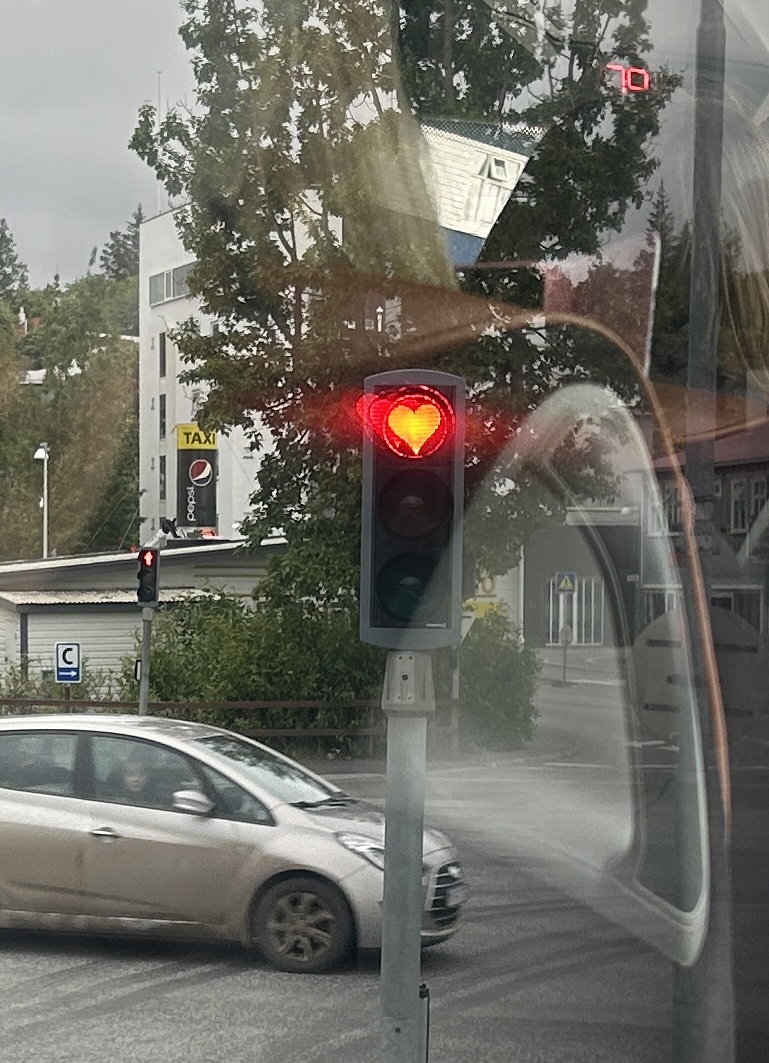
Because Iceland has so few people, many of them are related to each other. In fact, so many are related that there is an app that Icelanders use when they are dating to see how they are related. After all, you don’t want to fall in love with someone and then find out they are a second cousin and you shouldn’t have children.
We had an Icelandic tour guide in Norway who said she had to move to Norway to find a husband. Another of our Icelandic guides was from Italy. She said she had come to Iceland for a visit and was kidnapped by a Viking. Although her statement got a laugh, the Icelandic men appear to be getting wives in the traditional way. All of this means that, in general, the Icelandic culture is very homogeneous and hasn’t changed much over the centuries.
Even the language is ancient. Icelandic is the closest to Old Norse of any of the Scandinavian languages. It also has lots of odd letters left over from the days when things were written in runes. Tom has been figuring out how to pronounce things, but it is too complicated for me. There are several letters that all sound like “th”. If I’m listening to people speak, I can’t tell the difference between Norwegian, Icelandic, Swedish, or Danish. However, I can tell the difference if I see them written down.
One truly distinctive thing about Icelandic is how they say yes. It is pronounced “yeow” like meow with a y instead of an m. If you are listening to a variety of Scandinavians talk, you can pick out the Icelander by the way they say yes. Everyone else says “ja.” Icelanders spell their yes as “já” but it isn’t pronounced the way it looks.
Our guide taught us about Icelandic history from the time of settlement (before 900) to independence (1944). Livestock was very important to settlement. There are three kinds of livestock on Iceland: cows, sheep and horses. All of them were brought over from Norway at the time of settlement and developed into their own distinctive breeds. Today all these breeds are recognized for their hardiness. Icelandic sheep have a double coat. The cows and horses grow a long, shaggy coat in the winter and shed it in the summer.
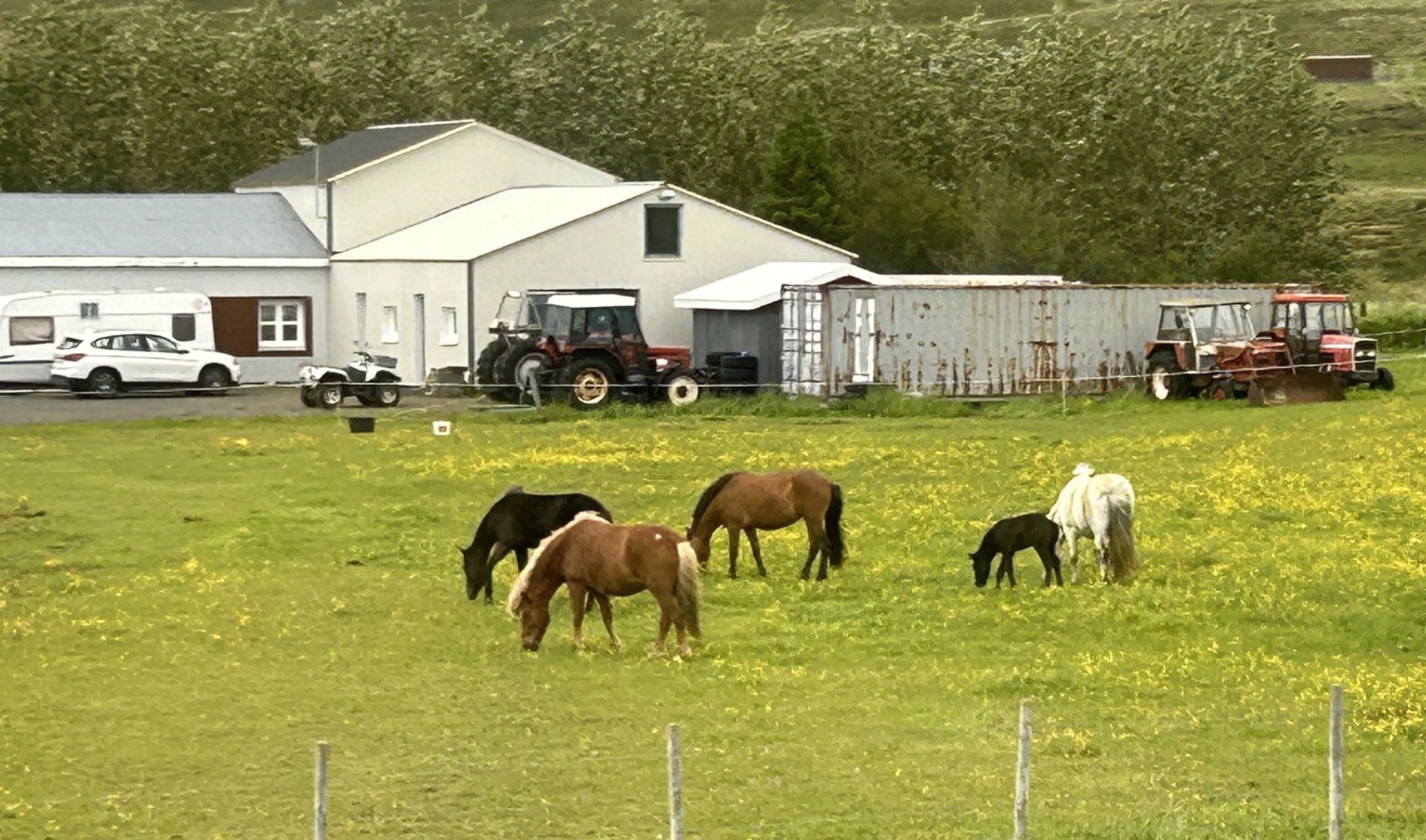
Icelandic horses are especially well known around the world because of their hardiness and distinctive gait. Other breeds of horses are not allowed to be imported into Iceland. If an Icelandic horse goes out of the country, like for a race, the horse is not allowed to come back into the country. In addition to the gaits of walk, trot, and canter/gallop, typical of other horse breeds, Icelandic horses can also do the tölt (ambling gait) and the flying pace.
Trees are very sparse in Iceland. Before human settlement, they covered about 10% of the land, mostly along the warmer coastal areas. But now trees only cover 1% of the land. The Icelandic Forest Service is trying to plant new forests, but the trees grow very slowly due to the harsh climate and high winds. One of the jokes that all our tour guides told us relates to the trees. “What do you do if you get lost in an Icelandic forest? You stand up.”
Our tour guide also talked some about the weather, especially around Akureyri. The hardest thing about the weather is the no darkness in summer and no light in winter. She said it wears on people after months and months. Consequently Icelanders have lots of festivals to keep themselves cheered up during the dark time. In the winter, Christmas lights go up on November 1 and stay up until the end of February. In Akureyri, they made their red stoplights heart-shaped to lift the spirits of the locals. She also told us that there are two kinds of weather in Iceland: good weather and refreshing weather.
Our tour started out in good weather. Although the temperature only reached a high of 46, there was a little sunshine peaking through. Our tour guide had given us all of the above information during our hour-long drive to Goðafoss. Once we got there, we had time to walk to Goðafoss and then walk around the area.
Goðafoss itself is gorgeous, similar to the Canadian Falls at Niagara. The Goðafoss waterfall is 36 feet high and 90 feet wide, and descends in a series of smaller falls toward the ocean. Spray rises from the force of the water coming over the falls. On sunny days there is a rainbow, but the weather had turned refreshing and there wasn’t any sun. Still very impressive.
After Goðafoss we stopped at a restaurant for lunch and then looked at the pseudo craters at Lake Myvatn. The pseudo craters are formed from steam erupting in fissures in the earth, rather than volcanic eruptions. They were interesting to see because there were so many of them. We didn’t have time to walk around at this stop because of the ice cream.
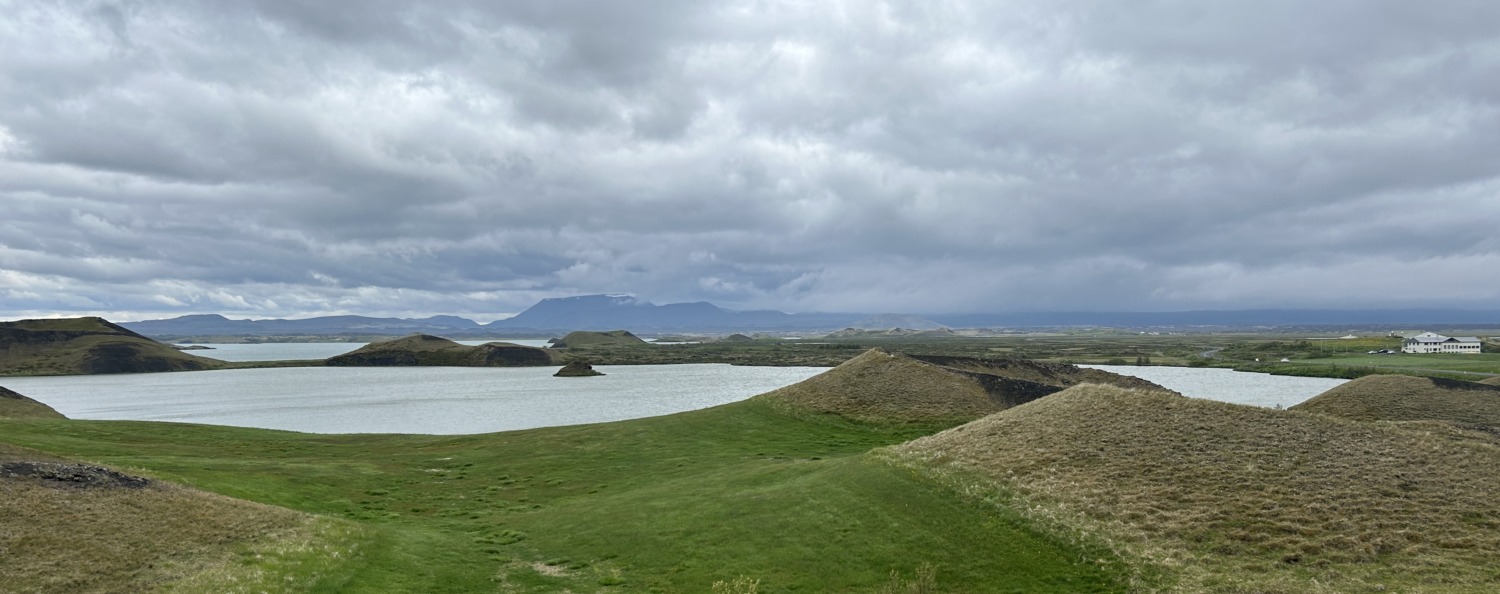
Icelandic cows are valued for the quality of their milk. Many of the dairy farms in the area increase income during tourist season by selling homemade ice cream. It is a soft and creamy ice cream similar to gelato but creamier. Tom and I had some whenever we had the chance. This farm had some interesting flavors with several containing salted licorice. The Scandinavians love licorice. I’m not much of a fan of licorice so I got some mint chocolate chip. Delicious. Because we weren’t allowed to take the ice cream on the bus, I had to forgo the walk around the pseudo craters to savor the ice cream. Worth it!
After the pseudo craters we traveled on to Námaskarð, a geothermal area with no vegetation, not even the usual moss. The barrenness is due to the heat beneath the earth, the acidity in the soil, and poisonous fumes being expelled. The ground contains vivid colors from the minerals in the water. Reds, oranges, yellows, and greens concentrate around the boiling springs and bubbling mudbaths.
The air smells like sulphur, a constant reminder of the powerful forces just under the crust. The smell stayed with me all day. We walked around the colorful and noisy pools and enjoyed the steaming piles of rock. Ropes separated us from the hottest areas. Fissures in the ground constantly emerge and close, so it is important to watch your step.
Our final stop of the day was the Dimmuborgir Lava Field, or lava labyrinth. Our guide told us about the Yule Lads who come to Dimmuborgir in November and December. An Icelandic Christmas tradition centers around a family of ogres. Grýla is an ogress with an appetite for the flesh of mischievous children, whom she cooks in a large pot. Her husband, Leppalúði, is lazy and mostly stays at home in their cave. They have 13 sons, the Yule Lads, mischievous pranksters who steal from or harass the population, and all have descriptive names that convey their favorite way of harassing.

The Yule Lads come to town one by one during the last 13 nights before Christmas. They leave small gifts in shoes that children have placed on window sills, but if the child has been disobedient, they instead leave a rotten potato in the shoes. During November and December the Yule Lads live in a cave in Dimmuborgir and parents bring their children to see them.
Dimmuborgir Lava Field is a park where people can wander around through towering lava formations. Some are said to be trolls that turned to stone when the sun came up. There are bridges, holes, and lots of sharp spires. Several trails lead through different parts of the labyrinth. We took the shortest one, the yellow trail.
Tom and I spent a little time in the gift shop and I was able to get an Iceland spoon. I also noticed a flag outside that said they had bread in a bucket from the underground bakery. Our guide said that people traditionally baked rye bread in a bucket in some of the geothermal holes in Iceland. They put the rye dough in a bucket, lower it into the hole and let it steam for 24 hours.
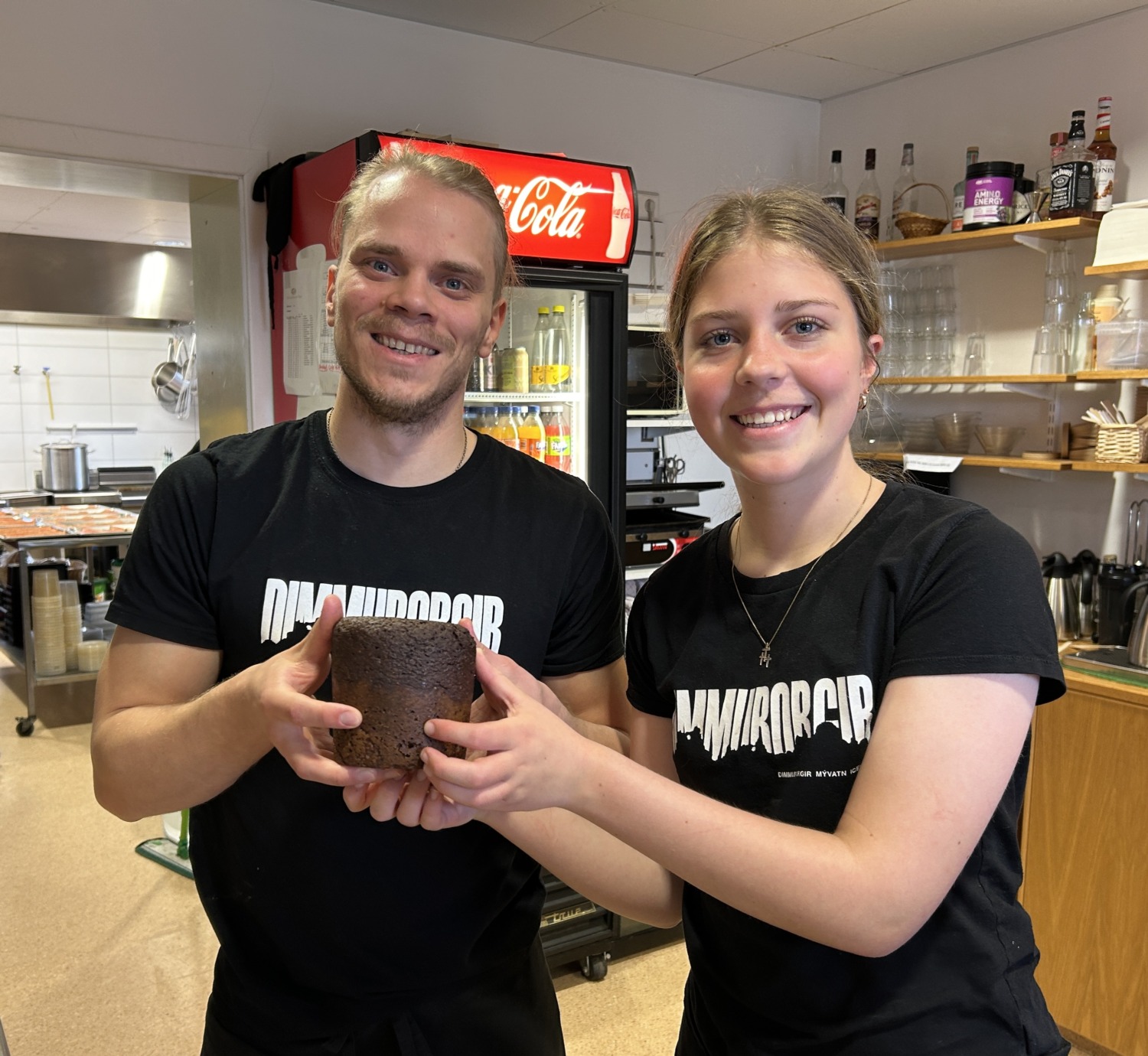
The restaurant sold it, so I had to see it. When I asked, they said they didn’t have any to sell at the moment, but they could show me a loaf that was just finished. Two of the young waiters modeled it for me. It was a very dark rye and looked delicious.
It was a long day out and about in the northernmost part of Iceland. By the end of the day the weather was even more refreshing, spitting rain and about 40 degrees. Tom and I were glad to get back on the ship, but we felt like we had seen some awesome things and learned a lot about this land of fire and ice. Goðafoss, and our knowledgeable guide, were the highlights of the day.




